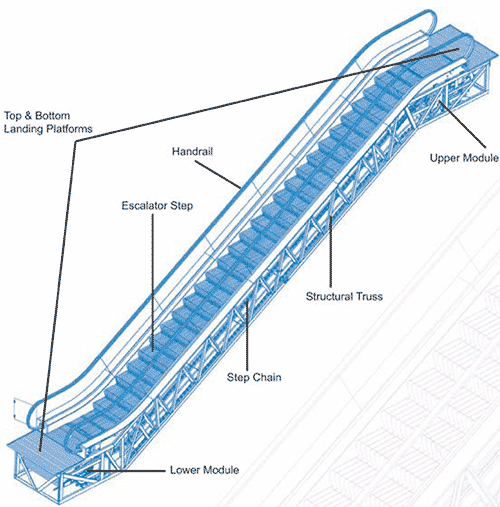Escalator Basics Today: How to Plan, Design and Update
BASIC ESCALATOR COMPONENTS
The essential components of an escalator include:
The structural truss. A truss is the main supporting structure of the escalator that bridges the lower and upper landings, composed of two side sections joined together with cross braces across the bottom and top of the structure. The ends of the truss are attached to the top and bottom landing platforms via steel or concrete supports. The truss carries all the straight track sections connecting the upper and lower modules.
Upper module step and handrail drive system, the main electrical and mechanical drive, is generally housed beneath thetop landing platform at the upper end of the unit.
| Escalator Components |
 |
Source: KONE Inc. |
Â
Early technology drive systems used worm gear drives that were about 70 percent efficient. They used a handrail drive chain/ linkage which, in turn, required high maintenance and messy oiling. In addition slippage often occurred because of faulty synchronization.
New technology drive systems are about 94 percent efficient and employ a planetary gear drive, which eliminates the handrail drive chain, messy oiling and synchronization problems. The planetary gear drive uses synthetic-based lubrication and has a 30,000-hour run before the oil needs to be changed, about twice that of conventional sytems.
Electrical drive systems have improved as well. Full voltage systems that required high amperage to start have been replaced with solid state soft-starting controls.
Many manufacturers also offer sensing devices, which monitor the load on the escalator and adjust motor voltage accordingly. This can result in electrical cost savings of up to 40 percent over conventional escalator systems.
The lower modulehouses the step return idler sprockets or lower reversing station. This lower reversing station component is now manufactured in cast steel, allowing for a quieter and smoother transition of the steps and chain around the lower end of the escalator.
Top and bottom landing platforms.In addition to housing the upper and lower modules, the top and bottom platforms anchor the ends of the escalator truss and contain a floor plate, a comb plate and comb segments. The floor plate provides a place for the passengers to stand before they step onto the moving stairs. This plate is flush with the finished floor and is either hinged or removable to allow easy access to the machinery below. The comb plate is the piece between the stationary floor plate and the moving step. The comb segments are mounted to the comb plate and are so named because their edge resembles the teeth of a comb. These teeth mesh with matching treads on the top of the steps. This design is necessary to minimize the gap between the escalator steps and the comb plate, which helps eliminate entrapments.
Step chain. Each escalator contains two step chains on either side of the unit. These are basically similar in shape to a bicycle chain, but much larger, and attach the steps to the mechanical drive system which continuously pulls the steps.
Historically these chains required constant lubrication, consuming up to 600 liters of oil in a 10-year period. Further, they made for an oily mess throughout the interior of the escalator that required regular clean downs that used strong solvents and detergents. Most manufacturers now offer a patented lubricationfree chain as a standard or as an option. These dramatically reduce oil consumption, eliminate problematic oiling devices, prevent environmental contamination and significantly cut downtime associated with housekeeping and maintenance.









